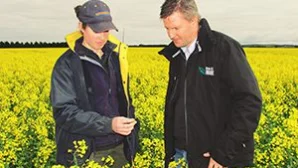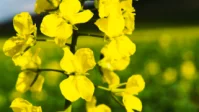Australia’s initial foray into canola production in the 1970s was a short-lived affair, with blackleg quickly decimating crops – along with the hopes of enthusiastic growers.
But thanks to the determined efforts of plant breeders, canola re-emerged in farming systems in the 1980s on the back of the release of disease-resistant varieties. It has now grown into a significant Australian commodity, producing an average 3.5mmt annually over the past five years and generating $1.6 billion in annual exports.
Its importance to Australian growers also extends well beyond immediately measurable export returns – canola plays a crucial role as a rotational crop, providing a break for disease management and an alternative tool in weed control.
The Grains Research and Development Corporation (GRDC), continues to prioritise investment in targeted research development and extension activities to ensure the industry remains one step ahead of potentially catastrophic diseases, particularly blackleg and Sclerotinia stem rot.
National Canola Pathology program
Underpinning canola’s success in recent times has been the GRDC’s National Canola Pathology (NCP) program – a major investment led by a world-class team of researchers that has generated considerable new knowledge and insights, delivering regionally-relevant, practical and highly effective outputs for growers.
“The NCP program was established to help maintain the canola industry and allow expansion of the crop into new regions,” GRDC Manager Diseases, Dr Friday Obanor, said.
“Over the past four years it has developed and delivered numerous outputs which have been met with rapid uptake by growers.”
These include:
• Publishing the annual Blackleg Management Guide used by most growers and agronomists to understand their risk of blackleg. It recommends appropriate management strategies including selection of cultivars for the coming season.
• Formation of blackleg resistance groups based on cultivars’ major gene resistance. The rotation of these cultivars with different resistance genes can be used as a tool for minimising blackleg disease.
• Creation of a disease monitoring system using the GRDC’s National Variety Trials (NVT) sites across the country. These sites determine which cultivars may be at risk of high levels of blackleg disease, and are also used to monitor Sclerotinia stem rot levels and other minor diseases such as white leaf spot, alternaria and downy mildew.
• Responding to new issues arising from changes to farming systems including the identification of upper canopy infection from the blackleg pathogen, its impact on yield and associated causes and potential control strategies. For example, the introduction of inter-row sowing, resulting in standing stubble, has changed spore release patterns and retention of infected stubble which may affect farm management decisions such as rotation.
The program – involving researchers from the University of Melbourne, Marcroft Grains Pathology, the South Australian Research and Development Institute, the Western Australian Department of Primary Industries and Regional Development, the New South Wales Department of Primary Industries and CSIRO – has also determined the best management practices for the use of foliar fungicides for both blackleg and Sclerotinia stem rot, including potential yield benefits.
It determined under what situations a two-spray program is economical for control of Sclerotinia stem rot and has also developed an in planta screen to detect tolerance to fungicides in the blackleg fungus. This led to a national survey, with the identification of tolerance to fluquinconazole (seed-dressing fungicide) in 15 per cent of Australian populations.
Other outcomes have included determining environmental triggers required for Sclerotinia stem rot to develop and identifying ‘hot spot’ regions where other minor diseases such as white leaf spot are consistently severe and may warrant control.
Economic benefits
Dr Obanor said while it was difficult to calculate the exact financial returns of the NCP program, there were examples where the NCP program had demonstrated measurable economic impacts.
“For example, the identification of blackleg populations that overcame Group D resistance, enabled researchers to warn growers on South Australia’s Eyre Peninsula to grow other cultivars that did not have Group D resistance in that region. The savings to growers were calculated to be at least $13 million dollars in a single season in that one region.
“In addition to reducing yield loss, this warning prevented the withdrawal of Group D cultivars from sale across the country, benefiting growers, breeding companies and the overall grains industry.”
With the Australian Oilseeds Federation projecting national canola production to reach more than 6mmt per year by 2025, the pressure from diseases will only increase.
To prepare for this scenario, the GRDC is about to invest in a new five-year phase of the NCP program, to further develop outputs from the most recent initiative.
“The project will monitor all diseases of canola and provide growers with management decision tools based on new knowledge about cultivar resistance, epidemiology, frequency, distribution and virulence of the pathogen populations causing blackleg, Sclerotinia stem rot and other diseases in canola – enabling growers to reduce input costs and potential yield losses.”
Pre-breeding to profitabilty
Taking a holistic approach to oilseed production, the GRDC has also invested in canola pre-breeding and agronomy programs.
Investments include:
• The National Brassica Germplasm Improvement Program which is focused on the difficult traits that are beyond the scope of commercial breeding programs. As new, appropriate germplasm is discovered it is offered non-exclusively to all canola breeders, ensuring companies have equal opportunity to use improved traits that target the priority needs of Australian canola growers. For example, in 2009 many new sources of blackleg resistance were made available to the breeding companies.
• The collaborative Optimising Canola Profitability Project which aims to lift canola profitability and reduce production risk by providing growers with tactical agronomic advice and support. The project has demonstrated that sowing canola early in most southern and eastern Australian cropping regions can increase productivity and profitability by following 10 key tactical guidelines relating to location, variety selection, soil moisture management, seed placement and rates, weed, pest and disease management, soil nutrition and croptop/windrow timing.
Visit GRDC’s website for more information: grdc.com.au

